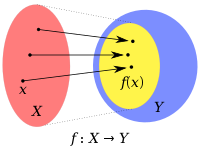Domain of a function

Okay, imagine you have a cookie jar. That cookie jar can hold a certain number of cookies, let's say 10. The cookie jar is like a function, which is like a machine that takes something in (in this case, cookies) and gives something back (in this case, how many cookies there are in the jar).
Now, the domain of a function is like the rules for what you can put into the cookie jar. For example, you can put cookies in the cookie jar but you can't put a pencil in there. So the domain of the cookie jar function is "cookies only".
In a similar way, the domain of a function is all the possible inputs or x-values that you can use for that function. So, if you have a function that tells you how much money you have based on your age, the domain would be all the possible ages you could have.
The reason why the domain is important is because it tells you what inputs (or x-values) you can use for a function. If you try to put in an input that isn't in the domain, it won't work, kind of like trying to put a pencil in the cookie jar.
So think of it this way - the domain of a function is like the rulebook for what inputs you can use, just like how the cookie jar can only hold cookies.
Now, the domain of a function is like the rules for what you can put into the cookie jar. For example, you can put cookies in the cookie jar but you can't put a pencil in there. So the domain of the cookie jar function is "cookies only".
In a similar way, the domain of a function is all the possible inputs or x-values that you can use for that function. So, if you have a function that tells you how much money you have based on your age, the domain would be all the possible ages you could have.
The reason why the domain is important is because it tells you what inputs (or x-values) you can use for a function. If you try to put in an input that isn't in the domain, it won't work, kind of like trying to put a pencil in the cookie jar.
So think of it this way - the domain of a function is like the rulebook for what inputs you can use, just like how the cookie jar can only hold cookies.
Related topics others have asked about:
